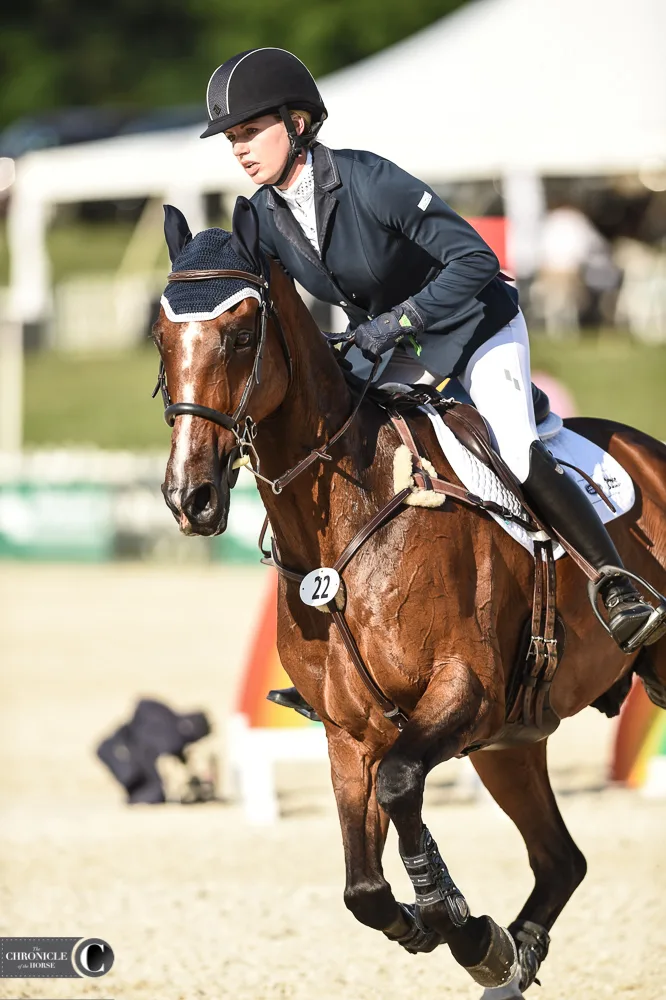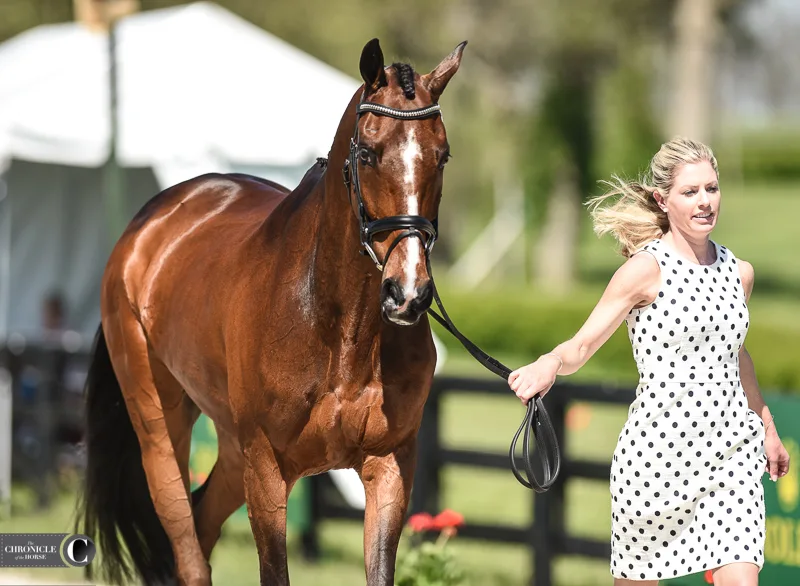Never Outfoxed fits the stereotype of Thoroughbred event horse to a T. A bit high strung and sensitive, the 13-year-old gelding (Veronica’s Sir—Caroverse, Opening Verse) is a cross-country machine and has been around the world to some of the biggest events with Holly Payne Caravella.
But in November 2017, Caravella wasn’t sure “Fox” would ever event again. She was away on vacation, and the gelding was enjoying some downtime as well. When she returned to her Oldwick, New Jersey, base, she found he was neurologic.
“He was in really bad shape,” said Caravella. “He could barely walk. He was trying. He could find his balance, but he was really bad. When the vet came, he failed all the neurologic tests. He’s always been a very animated, spirited horse, and he would hang his head low and was really depressed.”

Never Outfoxed rebounded from a serious EPM scare and a joint infection to come back to the advanced level with Holly Payne Caravella. Lindsay Berreth Photos
She took him to Greg Staller, DVM, DAVCS, at Running ‘S’ Equine clinic in Tewksbury Township, New Jersey, where they began the process of determining what was causing his neurologic symptoms.
“It was awful—really scary,” said Caravella. “No one had been riding him or anything.”
They started with bloodwork and a spinal tap, but results took about a week to come back from the laboratory. In the meantime, Staller started Fox on the antibiotic doxycycline and IV DMSO. When his results came in, his numbers were “off the charts” for equine protozoal myeloencephalitis, so he immediately began treatment with Marquis, an antiprotozoal oral paste used to treat EPM.
Fox’s turnaround was rapid.
“Greg said he’d never seen a horse respond so quickly to just a week of Marquis,” said Caravella. “He decided to keep him on the doxy for another couple weeks longer because he thought maybe the combination of the anti-inflammatory effect of the doxy plus the Marquis was working.”
Within Fox’s first week back home at Caravella’s farm, he’d made great strides, despite veterinarians being skeptical about a full recovery.
ADVERTISEMENT
“It’s such a scary disease, and it came on so rapidly,” said Caravella. “We just didn’t know. You don’t know if they’re going to respond to the medication. Of any horse to be a fighter, it’s going to be this one. He definitely fought his way to get better. Just being home, he was so much happier. We kept testing him every month. The numbers kept coming down, but we kept treating him. We ended up doing four months of the Marquis.”
Caravella moved her operation to Aiken, South Carolina, for the winter and gradually started jumping Fox again. In March 2018, she was away competing when her barn help called to say Fox had come in with cellulitis and didn’t want to bear weight on a hind leg.
“We immediately called the vet then because he’s super sensitive to everything,” said Caravella. “They put IV antibiotics directly into his leg, and they treated it aggressively from the start, but it went septic and went into his [right] fetlock joint, and we ended up spending another three months in the clinic [Performance Equine Vets] in Aiken.”
The cellulitis cropped up the same week Fox came off Marquis.
“I thought there had to be some association, but the vets said no,” said Caravella. “The only thing I could say is that maybe his immune system was slightly compromised, and it ended up allowing this cellulitis to go septic. I was fearful [the EPM] would come back, but it didn’t.”
Fox received joint flushes every other day for a month from Sabrina Jacobs, DVM, but the infection was stubborn. His veterinarians decided to do surgery to open up the joint.
“The body’s natural reaction is to create a lot of fibrin, and the infection was hiding in the fibrin,” said Caravella. “Then they finally got the infection to clear up, but it took three months, and they had been in the joint so many times, and it was so irritated. He wasn’t stable enough to go home until June.”
ADVERTISEMENT
Then the trailer ride home to the barn in Aiken made the infection flare again, and he went straight back to the clinic for another brief stay. Caravella was back in New Jersey at that point, so she left Fox in the hands of Kathy Hall, her former groom who lives in Aiken.
“She went every day and would visit him and groom him and hand walk him when he was allowed to,” Caravella said. “Since he’s so sensitive about his people that was awesome to have someone he knows there every day, and I think that was really helpful with his recovery. It flared up when he came home [to New Jersey], and he went back into the clinic for another week or two. We just took it really slow. We didn’t know if he would ever come back from it, because it had done some damage in the joint [and to the cartilage]. He was on stall rest for a couple months, and then we started turning him out gradually and doing some stuff.
“It was awful,” Caravella recalled. “I don’t know if it was just being naïve, but I always thought he would come back, but I don’t think the vets and everybody else thought that. Luckily they didn’t really tell me that; they kept me positive. I just couldn’t see him being ready to retire yet. Even if he doesn’t go back to the level I was riding at, somebody has to do something with him. He loves to work. He hates going on vacation, which is why we laugh about the EPM. It usually comes about in stressful situations. If they have it lying dormant in their system, they say that stress brings it out, and this horse has done events all around the world and never had an issue, but he went on vacation and was like, ‘Oh my God, this is too stressful.’ ”
Caravella and Fox returned to competition this past winter, completing the intermediate at Pine Top (Georgia), placing 10th in the advanced at the Cloud 11-Gavilan North LLC Carolina International (North Carolina) and finishing the advanced at Millbrook (New York) in August.
Caravella would love to contest the Land Rover Kentucky CCI5*-L in the spring. Together, they’ve finished Kentucky twice, as well as completing the Land Rover Burghley Horse Trials CCI5*-L (England).
“At this point, he has nothing to prove, so it’s whatever he wants to do,” said Caravella. “He feels great, so why not keeping him going? He’s super sensitive, so he’ll tell me if he’s not feeling 100 percent.
“He’s the horse of a lifetime,” she continued. “He’s not one that’s going to go be a team horse because he’s not going to be settled enough in the dressage, but he’s that horse for me that’s taken me around the world and given me the experience and the confidence to take on these big tracks. It’s really hard to get a horse that would do that for you. I have complete trust in him. He might be a little flighty and spooky, but he’s the one I trust more than anything that he’ll take care of me. To have a horse like that; I’m so grateful for it. It helps you, too, for every horse you have in the barn after him. It might be green or weak, but Fox has given me the confidence that I can take these other horses up the levels.”
Do you know a horse or rider who returned to the competition ring after what should have been a life-threatening or career-ending injury or illness? Email Kimberly at kloushin@coth.com with their story.

















